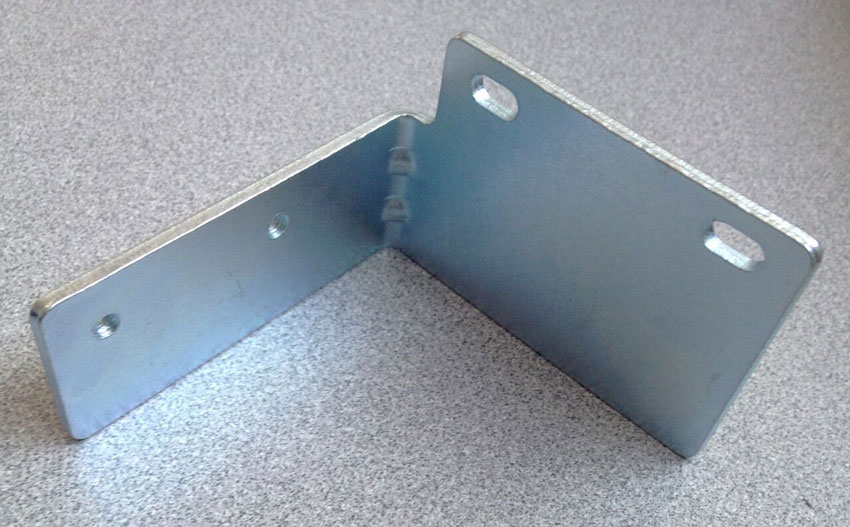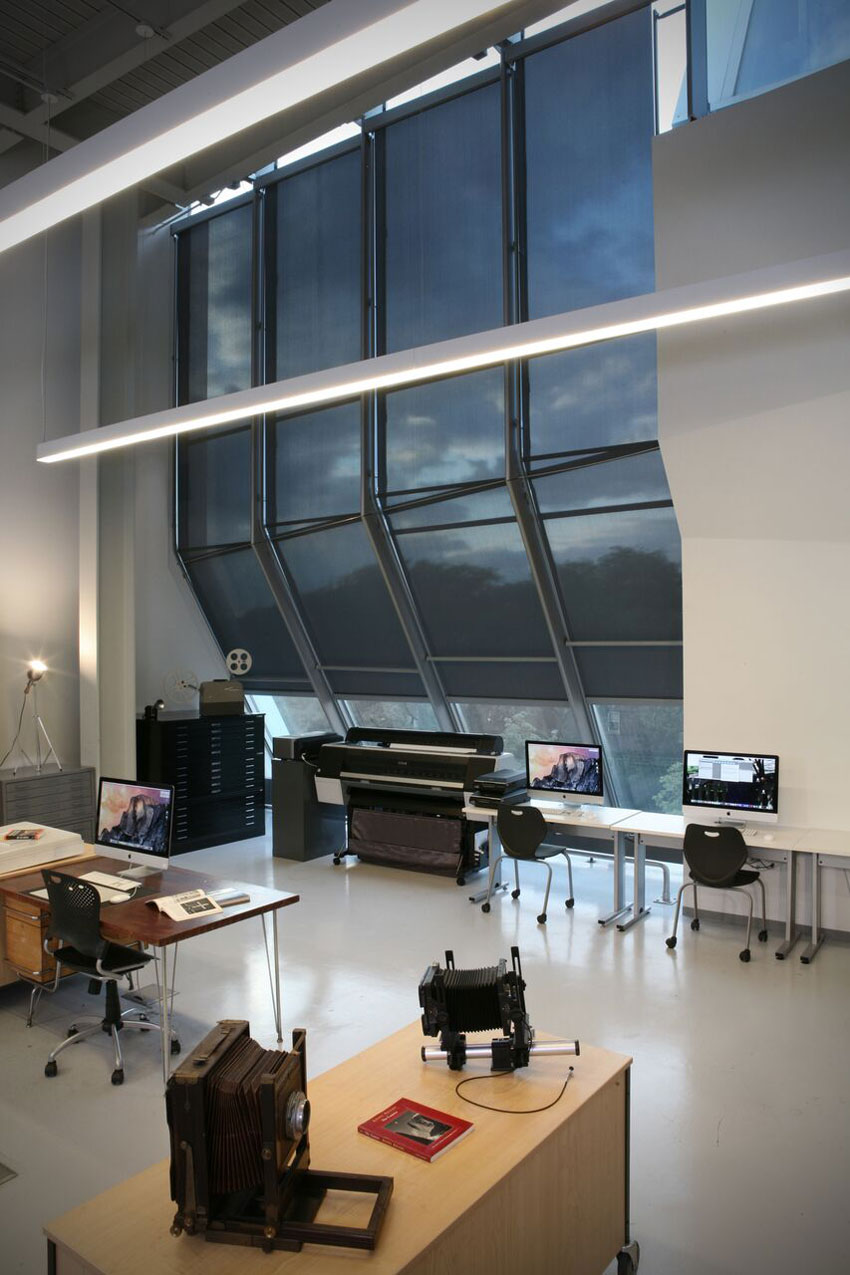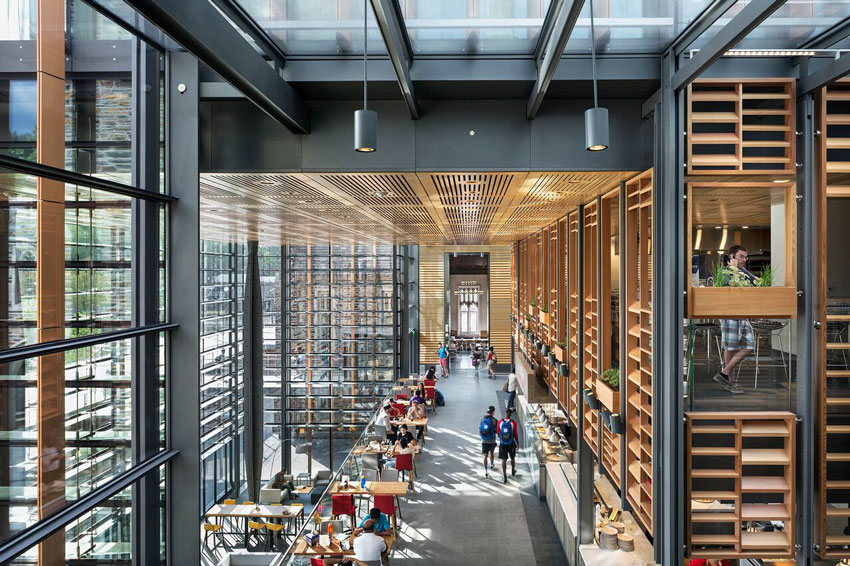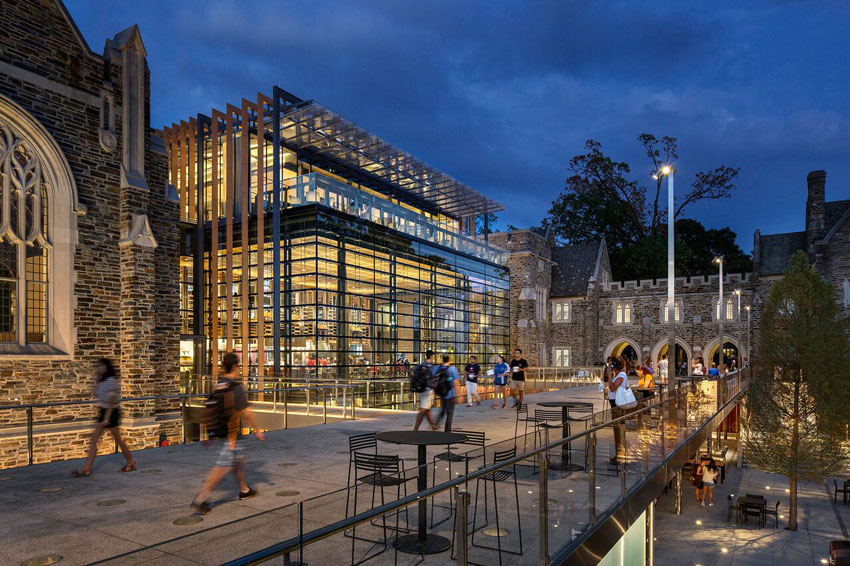Understanding the Benefits of Interior and Exterior Shading Systems
An alternative mounting solution—custom brackets that allowed the shades to be attached to the horizontal mullion—was designed. A 3-D drawing of the design was provided to the contractor, who provided suggestions for improvement.
The final step in the design process was producing 3-D printed sample brackets to test with a mockup section of mullion. The custom design was approved, and the brackets were manufactured. The installation began in May of 2015 and was completed in December 2016.

Photo courtesy of Draper, Inc.
The final bracket is designed to avoid attachment to the moveable storefront.
By understanding the issues, working with the design team, the facade contractor, and the installer, it was possible to make relatively minor adjustments to the shade bracket design to address a significant problem and to create an effective solution to allow the easy installation of the shades on the project.
While some roller shade projects might have issues to address regarding connections to the building structure, the selection of an appropriate fabric is important on all projects to ensure that the correct balance is achieved between appearance, daylight control, glare control, and views to the exterior. Two features that significantly impact the performance of a shading system are openness and color of shading fabric. In broad terms, openness refers to the area of the fabric through which light can pass, expressed as a percentage. Common openness factors are 1 percent, 3 percent, 5 percent, and 10 percent. The higher the percentage, the more light can pass through the fabric. In addition to light transmittance, a more open fabric also allows more solar energy to pass through it and be absorbed by the fabric or the building, carpets, furniture, etc. This solar energy, once absorbed, is converted into heat. Getting the correct balance between light and heat gain is therefore important and will vary across a building. Ranges of fabric that have a variety of openness factors therefore allow different versions of the fabric to be selected, as appropriate, while maintaining a consistent appearance throughout the building.
Fabric color also considerably impacts a shade’s performance. Lighter colors are better at preventing solar heat gain, as they reflect more of the solar energy than darker colors; they also allow more diffuse light transmittance. Conversely, the reflective characteristic of light colors makes viewing through the shade more difficult. Darker colors are generally better at controlling glare and light, and they are a better choice for preserving views, as they allow occupants to see through to the outside. The downside is that darker fabrics absorb more of the solar energy, which is then radiated into the room as heat. There is continuous development of fabrics, however, to try and address these issues with the intention of maintaining views to the exterior while achieving a good solar performance. Twill woven fabrics that are a light color on one side and dark on the other, metallized fabrics that increase reflectivity on the side of the fabric that faces the glazing, and chemical treatments that reduce the solar absorption of dark fabrics are all available options that can be considered during the fabric selection process.
The most common woven fabrics for shading systems are made from polyester or fiberglass yarns. Most fabrics also utilize PVC coatings to provide color and stability. PVC-free fabrics are becoming more prevalent, however, although they may not be appropriate for all shading requirements. With long drop shades, the stability of PVC-free fabrics can be an issue; this is also the case with fabric tension systems where the inherent stretch in PVC-free fabrics is an issue.
Because of all the fabric options available, finding the right solution can be a complex exercise. On larger projects, larger fabric samples can be supplied to allow the design team and the client to get a better understanding of fabric performance.
The University of Chicago Laboratory Schools case study shows how a modification to motorized shades and careful fabric selection were able to provide a solution to glare and heat gain in a building that contains large, uniquely shaped windows throughout.
The University of Chicago Laboratory Schools was building a brand-new arts facility, the Gordon Parks Arts Hall, funded in part by a donation from the George Lucas Family Foundation. It was a high-profile project that included effective daylighting as part of the design brief.

Photo courtesy of Draper, Inc.
A custom motorized system on tracks addressed the specific building conditions at University of Chicago Laboratory Schools.
The architects had developed a beautiful facade design with unique angles and breaks in the glass. With this design, however, they had a problem finding any solar shading that would work with the facade geometry.
Bryan B. Biggers III, president of Beverly Venetian Blind Company, says it was a complex project. He and his team talked to the architect in charge of the project to share some ideas on how to develop a solution.
After an exchange of ideas and on-site meetings, it was agreed that a custom motorized shade system should be developed to address the specific building conditions. The system would incorporate side guide tracks with redirectional rollers to allow the shades to follow the changes in slope. The shades would be operated via wall switch and feature a 3 percent openness factor.
One of the biggest challenges for the teams was the number of different brackets required to address the facade layout. With the changing break line in the curtain wall glass per shard, each shade was slightly different. There were different length tracks—both left and right side for each shade—different length brackets, and different quantities of brackets per system. Another issue was bending the side guide tracks. Three-dimensional engineering rapid prototyping machines and a process using printed plastic inserts allowed the solution provider to use a gym equipment tube-bending machine to bend the U-channel profile of the side guide tracks.
The project continued to be challenging as installation got underway. The shading systems were designed from the approved facade shop drawings. Biggers’s crew had to make some on-site adjustments and fabrication changes, however, because as they moved across the glazing, it soon became apparent that there were some changes from the angles shown in the drawings.
Specialized Solutions
While modified solutions are sufficient for some applications, at times, a more comprehensive solution is required in the form of a specialized outcome. Specialized solutions use existing products that are available in the European market but not generally known in the United States, but, on occasion, they can also require additional creativity and expertise to ensure the best results are achieved. These specialized solutions can be appropriate for both interior and exterior shading requirements.
A noteworthy example of this is the installation of a specialized solution at Duke University’s Richard H Broadhead Center for Campus Life on the West Campus.
The Richard H. Broadhead Center for Campus Life on the West Campus of Duke University was designed by Grimshaw’s New York office. The building is a modern addition to the Gothic-style Duke Campus and incorporates a substantial amount of glazing. In the base contract, the only glazing that was shaded was the upper level roof glazing as shown in the drawing below.

Photos courtesy of Jill Fredrickson/Front Inc.
Specialized shading systems were installed at the Richard H. Broadhead Center for Campus Life on the West Campus of Duke University.

The Richard H. Broadhead Center for Campus Life on the West Campus of Duke University features modern shading systems that stand out among the surrounding Gothic-style buildings on campus.









